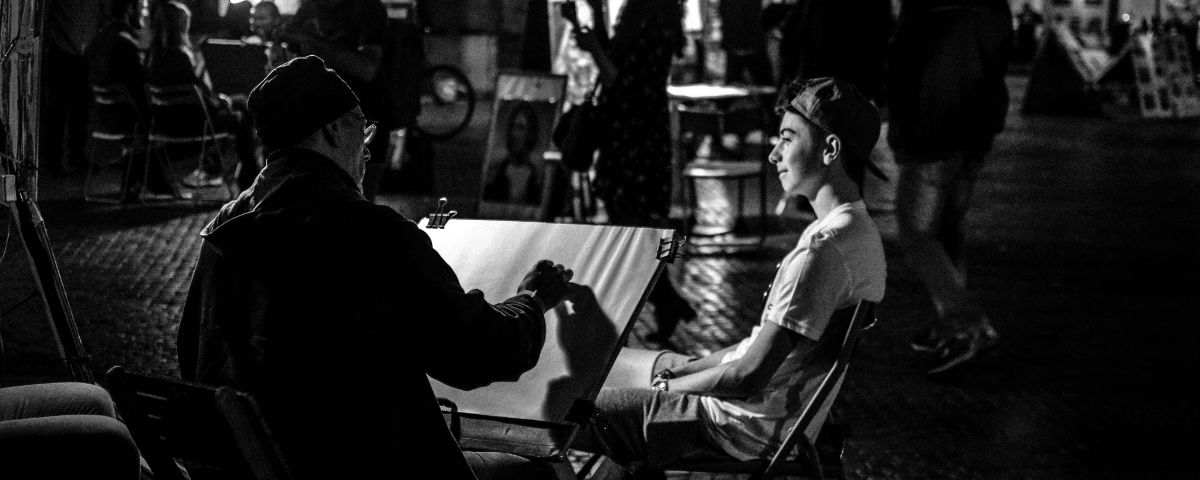
To Protect the Arts, Empower the Artist
To save the arts, society must guard the interests of creatives and instill a true sense of value for their work.
How many young people come into the arts with hope and enthusiasm, inspired by the great artists of history and modern creative icons, only to be crushed by the forces of the arts economy? It’s a story that many of us have seen or experienced first hand. While artists have historically been undervalued and even exploited by society, the modern creative market has turned creative work into a commodity, making it simultaneously ubiquitous, sought-after, and artificially “cheap.”
Should skilled artists profit from their work in their own lifetimes?
We need to realize that art appreciation is not only about heralding the unattainable works of long-dead masters, but also about ensuring that contemporary artists and creatives are fairly compensated for their works. Working artists must be fairly paid for their creations so that they may continue to create. In addition to promoting the beauty of art, arts organizations also need to educate the public about the training, expense, and time required to not only produce an individual piece of art, but to attain the level of skill required to produce the artist behind the work.
If people knew how hard I worked to get my mastery, it wouldn’t seem so wonderful at all. ~Michelangelo
We must work to demystify the creative process and help people to understand that art does not appear magically from the aether. Even the most talented young artists have dedicated much of their lives to the quiet mastery of their skills. They have sketched, sculpted, composed, and practiced for hours upon hours, often behind closed doors, to be able to create the final artworks that are eventually revealed to the public. To the uninitiated, this appears as if the artist has arrived at the top of a mountain by helicopter, when, in fact, she spent years planning, training, and finally scaling treacherous cliffs and braving freezing temperatures to arrive at the summit.
While it is often because the work of an artists takes place in private that people do not properly value creative works, it is also true that artists bear some responsibility for their lack of appreciation among the general population. Sadly, creators can be guilty of seeing their work as emotionally priceless and commercially worthless. Even many of the great artists of history have been guilty of undervaluing their creations, letting works that now sell for millions of dollars go for a pittance.
I put my heart and my soul into my work, and have lost my mind in the process. ~Vincent van Gogh
Art is something that almost all people want but it is not universally valued, and many “fans” of art have been willing to exploit the low self-value of talented artists in order to acquire their work. A competitive arts market has only made this problem worse, pitting artists against one another in a race to the bottom. Young artists are often willing to work for an unlivable wage to break into the market. As a result, the wages of established artists are artificially deflated, even though the demand for art and design only increases as we live in an ever-more designed and marketed world. The art and design market operates in contravention to the principles of supply and demand, primarily because the public AND artists do not properly value the arts. It is only by educating the public about the artistic process, as well as educating artists to properly value and price their skills that we can create an economy where people are able to sustain themselves as creatives.
Unfortunately, so far as the argument for the value of art is concerned, it has primarily come from those who have been some of the most egregious exploiters of artists. We have seen the self-serving argument of movie studios and recording labels against piracy, claiming that it is theft against the artists. In fact, they have acted primarily to preserve their own profits and to extend their antiquated business models, encouraging artists to sign away their long-term rights in exchange for (often) empty promises of short-term gains. The artists rarely reap the rewards of mass distribution or, at the very least, are compensated disproportionately. Again, this is largely a side effect of poor education about the arts, as well as poor business education of artists. A more informed public and a more empowered creative community would likely help to shift this long-standing power dynamic.
Solutions
We can’t simply gripe about the state of things and not take action to make them better. Never has there been greater opportunity for artists to act individually and collectively to overcome the challenges that have faced the creative community for ages. Even though things may feel like they are headed in the wrong direction, there are concrete actions we can take to turn the ship around.
Instill a sense of the true value of art in both the general public and in artists
In any market, it is important for both producers and consumers to be educated about the factors that affect the creation, availability, and pricing of products and services. It may be in the interests of the majority to have access to inexpensive art, but only in the short term. To ensure that artists are able to continue creating art that people want, artist and the organizations that support them need to engage in a campaign of public education. Subtly including information about training, experience, cost of materials, and other quantifiable aspects of the creative process can be important. However, the real key to shifting public perception of art and artist is storytelling — creating a personal connection between artist, art, and viewer. Especially today, the rise of video in social media allows the artist to share their work, process of creation, and her/his own personal story with the public. Developing a bond between the artist and the art consumer will not only make it less likely that the artist will be undervalued or exploited, but also more likely that the consumer will become a supporter and advocate of the artist’s work.
Offer outlets for emerging and established artists
To further aid artists in making a living, we must also ensure that their works are physically accessible to the public. Not every piece of art is easily conveyed via printed page or digital media; to be experienced properly, they must be viewed/heard first-hand. Cooperative workspaces, galleries, and venues are an excellent way for artists to work together for the common good. They promote a sense of community and solidarity, while also allowing artists of varying experience, media, and personalities to crowdsource the tasks of promotion, interaction, and sales.
Advocate for public funding of the arts and arts education
If we believe that art is fundamental to society and contributes to the full development of the human mind, we must make art universally accessible, regardless of geographic location or level of income. Armed with the overwhelming evidence about the benefits of art, we should petition government officials at every level to make art funding a budget priority. Likewise, we should advocate for public arts projects so that as many people as possible can be exposed to the beauty and power of art on a daily basis.
Support organizations that empower artists
There are a number of organizations, foundations, and associations that advocate for the arts and provide services, support, and education for artists. At the local level, art clubs provide exposure and opportunities for artists to connect with one another. This can be an important starting point, especially for artists located outside of larger urban markets. Much like cooperatives, arts organizations can provide support for artists that might not otherwise be available (or even known) to the individual. They can often provide networking opportunities and connections with civic leaders and business owners. Also, When properly managed, organizations and artists can work together boost marketing and public outreach.
At the state, national, and international level, larger organizations can advocate for greater funding for arts education and public art. They can also work together to establish ethical practices and fair pricing guidelines, as well as provide access to collective resources in the form of grants, micro-loans, educational/training resources. Large or small, if you value the arts, it is important to support arts organizations by donating, volunteering, or advocating for the cause.
Conclusion
Both artists and people who love art must take action to ensure that the world is constantly renewed with the works of gifted and undiscovered creatives. We cannot rely of the works of the classical world to stand alone as crumbling monuments to the greatness of human civilization. Instead, we must fight for art that reflects the world as it is in our own era, produced by the people who are experiencing it at the time. We can create a world filled with beautiful art, created by people who are appreciated and properly valued for their work.
Visions are worth fighting for. Why spend your life making someone else’s dreams? ~Tim Burton
It is the artist, not the completed masterpiece, that is of great value. The works of the great painters are not invaluable because they are unreproducible; they are invaluable because they represent the intimate and finite work of gifted individuals. After all, how can we know that the next Rembrandt, Picasso, or van Gogh wasn’t chewed up and spat out by an economy that demands endless masterpieces at bargain-basement prices?
Could Kulture Partners help you?
We're here to help you do great things! Send us a message, right now, to find out if we're a good fit. Someone will contact you to discuss your specific goals.
Don't worry, we are NOT a high-pressure agency.
